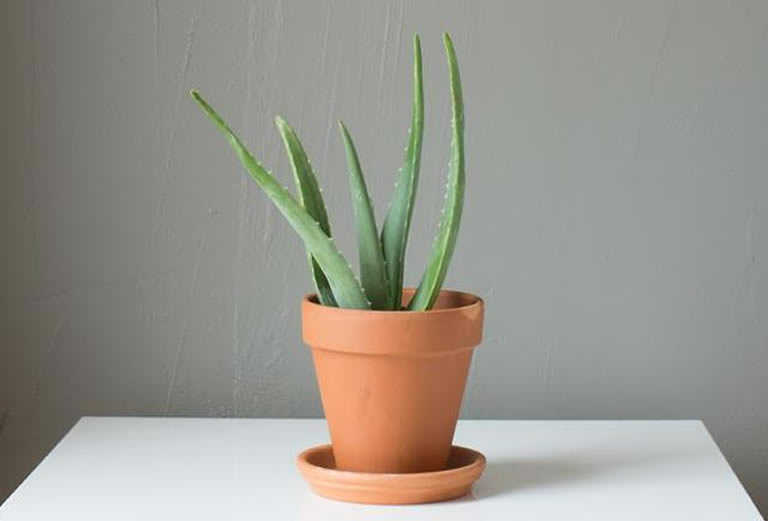In this article I cover everything you need to know about growing an aloe plant – this includes the very popular aloe vera. I outline how aloe grows, how to get it to grow faster, how to get it to grow bigger and how to get it to grow better.
I also cover how to quickly propagate new cuttings and offsets to grow new aloe plants.
Table of Contents
HOW TO GROW ALOE PLANTS
Aloe plants are easy-care succulents that grow really well as houseplants. Aloe are tropical and subtropical plants that grow in parts of Africa as well as several islands in the Indian Ocean. They can also be found in Madagascar, the Arabian Peninsula and Jordan.
These plants have evolved to grow in dry, warm climates and so are unsuitable for outdoor use in most US states. If you live in USDA climate zones 10 or 11 though then you can cultivate aloe plants in the yard fairly easily but for everyone else it becomes a much more complicated process (see our guide to growing aloe plants outside).
Aloe plants make a much better indoor plant, at least in the US.
Except in USDA climate zones 10 and 11, aloe plants should be grown indoors.
If you plan to grow an aloe plant, no matter which particular species you choose, you should aim to cultivate it as an indoor houseplant as most homes have consistent temperatures throughout the year and also offer a way to regulate the plant’s water intake and other care needs.
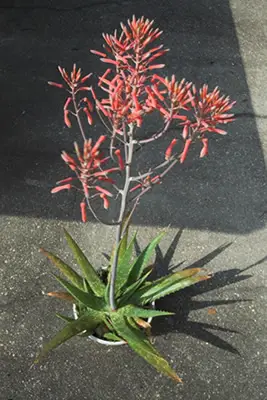
When grown in the correct conditions, and given the correct care, aloe plants will bloom each year and produce colorful, unique flowers in a range of different colors.
The 3 ways to grow aloe plants indoors
Let’s now look at how to grow aloe plants in pots indoors.
How to grow aloe plants from seed
Later in the article I will show you how to grow a new aloe plant through propagation but before I do that let’s take a look at how to grow these succulents from seeds.
Before seeding aloe plants you must make the correct preparations.
You will need:
- Succulent soil made up of compost, perlite and sand.
- Small plastic containers or plastic grow pots.
- Tenting or plastic bags.
- Aloe plant seeds.
Some people will prepare the soil themselves (as I demonstrated how to do in the aloe plant soil guide) but a good succulent soil will more than suffice.
Some indoor gardeners will also sterilize the soil before they seed it but I think this is unnecessary. However, if you wish to do that all you have to do is microwave the soil for about 3 minutes and then stir it when its finished. Allow it to cool before adding any seeds.
Begin by placing the soil into plastic containers or small plastic pots that have good drainage.
I usually prepare about 5 containers as this gives me the greatest chance of at least one of them producing healthy growths, though if you do this right 2 containers will usually suffice.
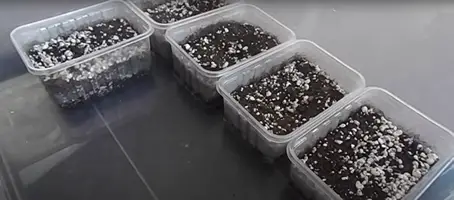
Set the soil-filled containers into a sink or large container filled with water.
The water should be at a level that is 1 inch above the bottom of the pot/container with the soil in it, so you don’t need much. The aim is to allow the soil to slowly soak up the water from the bottom so it becomes moist.
Let the containers soak for 15 – 20 minutes or until the soil is moist. Remove the containers from the water and allow them to fully drain while you prepare the seeds.
Aloe plant seeds are fairly small though they are usually big enough to plant by hand unlike some other succulents. So you should have no problem planting the seeds manually.
The seeds should be spaced evenly apart with about 1 inch between each seed.
Press larger seeds gently into the soil. Smaller seeds can be left to sit on top of the soil. If you have very small seeds you can use a piece of folded paper to hold the seeds and then shake them evenly over the soil (like dusting a cake) or you can simply run them down the container in straight lines.
Now that you have seeded the soil you should place a tent (like this one) over the containers or you can place a separate clear plastic bag over each container individually. This will help maintain the heat and moisture levels around the seedlings as they grow.
The containers should be placed in a well lit area that gets at least 6 hours of direct light per day. You can use a grow light to ensure the seeds get enough light and warmth but you should only leave the light running for 6 – 10 hours during the day.
There will be enough moisture in the containers to ensure you do not need to water the seedlings as they grow. After a few weeks, to a few months, you will see new shoots emerge from the soil and once the new seedlings have grown to a few centimeters high you can remove the tenting if you wish or leave it in place until the plants are more established.
How to propagate & grow aloe from offsets
Of course growing aloe plants from seeds isn’t the only way to cultivate new plants. One of the most popular ways for starting new plant growth is through propagation.
Propagating aloe plants is fairly easy and I will show you how to do that now.
There are two ways to propagate an aloe plant. They are:
- Removing an offset from the parent plant.
- Taking a cutting from a plant.
By far the easiest way to grow a new aloe plant is by removing an offset from an established mature plant.
Offsets are actually new tiny plants that grow to the side of the parent plant. By removing them, ensuring some of the root system remains attached to them, it is easy to grow an entirely new plant.
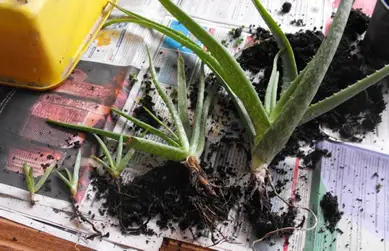
An aloe plant can have multiple offsets growing on the parent plant at the same time and each one of these represents the opportunity for growing a new aloe plant. I covered exactly how to do that here.
Once removed and potted, each new offset is essentially already a new plant and all you need to do is give it the same care you would any other aloe plant. This approach is so simple and requires so little extra care that it easy to see why it is the most effective way for propagating new aloe plants.
How to propagate & grow aloe from cuttings
Propagating new plants from cuttings is a well established way of cultivating new plants.
By taking a leaf cutting from a plant and then treating it in a very specific way it is possible to get the cutting to develop new roots and eventually establish a new plant.
However, propagating an aloe plant from a cutting is a much more risky endeavor than it is with other plant types because many times an aloe cutting will die long before it has had a chance to develop roots.
Having said that, there are ways to do it which I will show you now.
Can you grow a new aloe vera plant just from taking a cutting?
You can grow aloe vera from a leaf cutting but it is not always a successful process. It is better to propagate aloe vera from offsets rather than trying to root a cutting.
There are methods you can employ to increase your success rate propagating from cuttings however.
As aloe vera is no different than all other aloe plants, as far as care and propagation needs go, you can follow the advice given the sections directly above this one if you want to grow aloe vera from a cutting.
HOW TO MAKE A NEW ALOE PLANT GROW ROOTS
Once you have taken a cutting from a mature aloe plant you will want to take actions and treat the cutting in a way that will promote root growth.
You can make a new aloe plant grow roots i.e a cutting, by placing it in water or soil.
The key to effectively rooting an aloe in soil
Although a cutting will sometimes develop roots if placed in soil directly after being removed from the parent plant it should be allowed to dry out slightly before potting as more often than not the leaf will rot before it has had time to grow roots.
The following information also applies if you want to know how to grow aloe vera from leaf.
If you intend to propagate an aloe leaf cutting in soil then be sure to allow the cut leaf to dry slightly before potting it. You do this by allowing the cut leaf to develop a film over the area that was cut. Only then should you pot the cutting.
Failure to do this, by planting the cutting as soon as it is removed from the plant, will result in the leaf rotting before it has time to develop roots.
Once the point of the cut on the leaf has sealed itself you can place the cutting in a small pot or container filled with succulent soil (cactus soil works best).
Mix some liquid root hormone into sterilized water (water that has been boiled in a kettle and allowed to cool) and water the soil. Ensure the pot has very good drainage as your cutting should never be allowed to sit in drenched water.
Allow the soil to dry out before watering the cutting again. If the leaf does not rot it will develop new roots in about 4 weeks.
Aloe plants can also be rooted in water but they can’t grow in it indefinitely
The aloe is a succulent that can go fairly long periods without water.
I’ve highlighted in several articles how succulents are very susceptible to root rot that comes from overwatering so you may be wondering why some indoor gardeners advocate growing aloe plants in water. Is this even possible?
An aloe plant can grow in water but this is usually only done for a limited period and usually when trying to propagate a new plant. Once roots start to form on the aloe plant it should be removed and planted in succulent soil. If left in water indefinitely the roots will rot and the plant will die.
Taking part of an aloe plant, or aloe cutting, and immersing it in water (add some floral feed for liquid rooting hormone to it) it is possible to get aloe cuttings to root.
HOW TO MAKE AN ALOE PLANT GROW BIGGER & STRAIGHTER, FASTER
Now you have started a new aloe plant you will want to give it the best chance of reaching its full potential.
Follow the advice below to ensure your aloe grows straight, with large foliage in the fastest possible time.
How to make an aloe plant grow bigger
Many aloe plant owners are dissatisfied with the size of their plants. Below are some tips to ensure you aloe grows as big as you want it to.
You can make an aloe plant grow bigger by repotting it in a bigger container. Fertilize the plant twice per month during growing season to encourage larger growth.
Ensure the plant gets plenty of direct light (no less than 6 hours per day) and ensure it’s kept at temperatures above 55°F but below 80°F.
A word of caution: be very careful when fertilizing your aloe plant. This succulent is a very light feeder and usually only requires feeding once per year.
But, to encourage larger growth, you can fertilize your aloe twice per month during the plant’s active growing season (April through September) but never feed it with full-strength fertilizer.
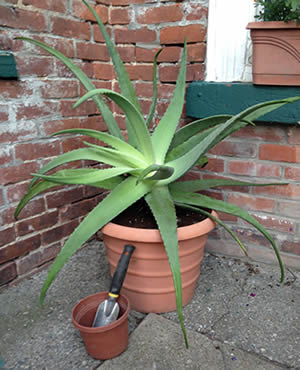
Make sure you do not use full strength fertilizer on any of your aloe plants unless you are using one that has been specifically formulated for aloe plants or aloe vera. This includes succulent fertilizer!
Even if you are using a good succulent feed always dilute the fertilizer to half the strength that is recommended on the product label and never fertilize the plant during the winter when it is at rest.
As well as fertilizer make sure the aloe is getting plenty of direct sunlight when you want to encourage growth.
Aloe plants are desert succulents that have evolved to thrive in strong direct sunlight. Although, like any plant, too much strong UV rays can bleach the foliage and lead to leaf burn, aloe plants are well adapted to sitting in full sun. In fact, these succulents need at least 6 hours of strong direct sunlight per day if they are to reach their full potential and if they are to bloom.
So, if you want your aloe plant to grow bigger, as well as taking the steps mentioned above, make sure your plant gets plenty of direct light.
When I want to encourage overall growth and increase the size of an aloe plant I will ensure it gets approximately 10 hours of direct light per day. Although 6 hours of daily direct light will suffice I find that giving the plant at least 10 hours greatly increases the size of the plant and the speed at which it grows.
If you need to, use a grow light to ensure your plant is getting the recommended daily dose of light.
As I already mentioned aloe vera is the most popular aloe plant that is grown indoors. So, if you have an aloe vera plant then you may be wondering if there is anything you can do specifically to make it grow bigger.
The process is exactly the same for any other aloe plant.
To make aloe vera grow bigger fertilize the plant twice per month during growing season using feed made up to half strength. Repot it in a larger pot and ensure it gets between 6 – 12 hours of direct light per day (preferably 10) in temperatures that do not fall below 55°F but that do not exceed 80°F.
Aloe vera are subject to the same care requirements as all other aloe succulents so you can follow the advice given in the sections above to ensure you aloe vera grows fast and big.
How to make an aloe plant grow straight up
One of the most common problems I encounter with aloe plants is leaning foliage. If you have an aloe plant that is not growing straight up there is likely only one of several potential problems at play.
To make an aloe plant grow straight up you should ensure the whole plant is getting equal amounts of light. If your aloe plant is leaning to one side it will be literally leaning into the light. Move the plant to a place that has good all-round lighting or use a grow light.
Alternatively you can rotate the plant every day to allow for full light exposure to all areas of the plant. If all the foliage is drooping this is an indication of a much more serious problem that you must address immediately.
By far the most common reason for a non-straight, or leaning, aloe plant is insufficient light.
Aloe plants require at least 6 hours of full sun per day to remain healthy. So, if you have a plant that is situated in an area of your home that has limited light, i.e. where one side of the plant is in light and the other side is in shade, then the aloe plant will lean towards the light.
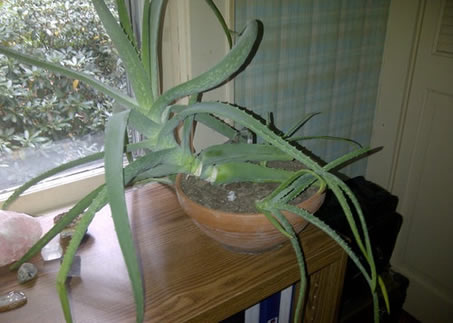
Although it is always best to simply move your plant to a better lit area of your home this is not always a readily-available option. Luckily, a small grow light can help to make up the difference caused by insufficient natural light in such cases.
Alternatively you can rotate your plant each day to ensure it gets light to all areas of the plant, however the plant is unlikely to bloom or ever reach its full potential as there is obviously insufficient light in that particular area – better to move the plant to a better lit location or use a grow light.
Read the article about aloe sun and light requirements for more information on light needs of aloe houseplants.
How to make an aloe plant grow faster
Is there a way to speed up the growth stages of an aloe plant?
- To make an aloe plant grow faster first ensure it is growing in a pot with good drainage that’s filled with succulent soil.
- Good, strong direct light is essential for fast growth and the plant should receive about 10 hours of sunlight per day or at least a minimum of 6 hours.
- Using a grow light can help speed up the growth rate of an aloe plant.
- Temperatures should not be allowed to fall below 55°F or go above 80°F.
Aloe plants grow pretty fast normally so if you have a slow growing plant I would look for potential causes in the environment and your care routine. By far the most common reason for a slow growing aloe succulent is insufficient light.
Now there can be more serious problems behind slow or halted plant growth, such as root rot (see our aloe vera root rot guide), but if this is the case then the slow growth will always be accompanied by other signs such as a yellowing of the leaves or a drooping of the leaves etc. (see our aloe plant leaves guide for more info).
If the leaves are browning or turning black then they are showing signs of distress in the plant and you must take immediate action as outlined in this article.
Sometimes the above mentioned symptoms can be accompanied by a strong smell while others times the plant will show no visible signs of distress but will give off a strong odour. This is usually a sign of rot in the plant. If your plant has a strong smell you should take the actions outlined in the article why aloe sometimes smell bad.
If your plant is not showing any signs of distress other than a lack of growth then the cause is almost certainly down to a lack of direct light.
The quickest fix for speeding up the growth rate of an aloe plant is to move it to a better lit area of your home. Ensure the plant is getting a minimum of 6 hours of direct light per day. If you cannot provide enough direct light then consider using a small grow light like the one I linked to in the section above.
If the plant does not respond to extra light then the problem may lie in the soil. Although you can add a succulent feed to the soil I think it is much better to simply repot the plant in fresh cactus soil.
Another contributing factor to slow aloe plant growth can be the temperature around the plant.
Aloe plants need warm temperatures to thrive and the type of high temperatures they like are sometimes lacking in homes as humans do not feel comfortable at the type of high levels of heat that most succulents thrive in. It is therefore necessary to artificially create the right warmth levels around your aloe plant to ensure it has the best conditions possible for fast, healthy and vibrant growth (and to ensure the plant blooms).
This may mean placing your plant closer to a radiator or heat vent or you could simply use a grow light (which will also offer the plant additional light as well as heat) or a small heat pad underneath the pot.
As aloe vera is the most popular aloe plant grown indoors, at least in the US, it stands to reason that many aloe houseplant owners want to know how to specifically grow aloe vera faster.
To make your aloe vera grow faster give the plant about 10 hours of direct light per day but no less than 6 hours. Consider the use of a grow light to speed up the growth rate of an aloe plant. Make sure the plant is growing in a succulent soil and good-draining pot with a temperature range from 55°F – 80°F.
As aloe vera requires the same care routine as all other aloe plants you can follow the more detailed information given in the section above for increasing the growth rate of your aloe vera plant.
Once grown an aloe plant can live a long time
Now that you have started a new aloe plant you may be wondering how long your new succulent will live.
Aloe plants can live for decades. Some aloe plants will live up to 25 years when given the correct care. You can expect an aloe houseplant that is given sufficient care to live between 5 – 25 years.
While many aloe houseplants will live for around 5 – 10 years if you give your plant the ideal care you can expect it to live a very long time. Many aloe plants will live as long as 25 years when their care routine is ideal and consistent.
Most aloe houseplants die of illness/disease or lack of care before they die of old age.
RECAP: How to grow aloe plants from seed, offsets or cuttings
Although many householders grow aloe vera so they can harvest its latex, when they cut the aloe leaves, most aloe plants are grown for houseplant decor because they are easy to look after and have very unique blooms.
There are 500 different species of aloe plant but luckily all of them require a similar care routine. So regardless of which specific species you have, you can rest assured that the following information will apply to your chosen aloe plant.
Although aloe succulents are easy-care plants there are a few things you must do to give your plant the best chance of healthy growth and yearly blooms.
Below are the requirements necessary for successfully growing an aloe plant.
Aloe plants require:
- The correct type of container: A pot made from a porous material with good drainage works best. Aloe plants like moist soil but they hate drenched soil. The pot must have sufficient drainage and be porous to allow for good water drainage. I prefer terracotta pots because, as well as preventing water build-up due to their porous nature, they also help maintain good humidity levels for plants and because they look great with succulents.
- The correct soil: Aloe plants require a succulent soil. I use cactus soil (see my aloe plant soil and pot guide) as it is fast draining, slightly dry and contains a good mixture of nutrients without being overly rich like standard potting mix.
- A correct watering routine: Making sure you know the correct watering requirements of your plants is by far the most important thing to consider as part of your care routine especially when it comes to succulents. Succulents can suffer from a wide range of problems due to incorrect watering, the most notable being root rot. Follow the advice in our aloe plant watering guide to avoid potential problems caused by both overwatering and also underwatering.
- The correct amount of light: Place your aloe plant in a location that gets at least 6 hours of good direct sunlight per day.
Get the above four simple aspects of aloe plant care correct and you will ensure that you have a healthy plant that blooms year-on-year for years to come.
Once you have the correct items in place, namely the correct pot and correct soil, you can begin the process of cultivating aloe plants. I will show you how to propagate new plants from cuttings later in this article but first let’s look at how best to encourage fast, healthy growth in a potted aloe plant.

